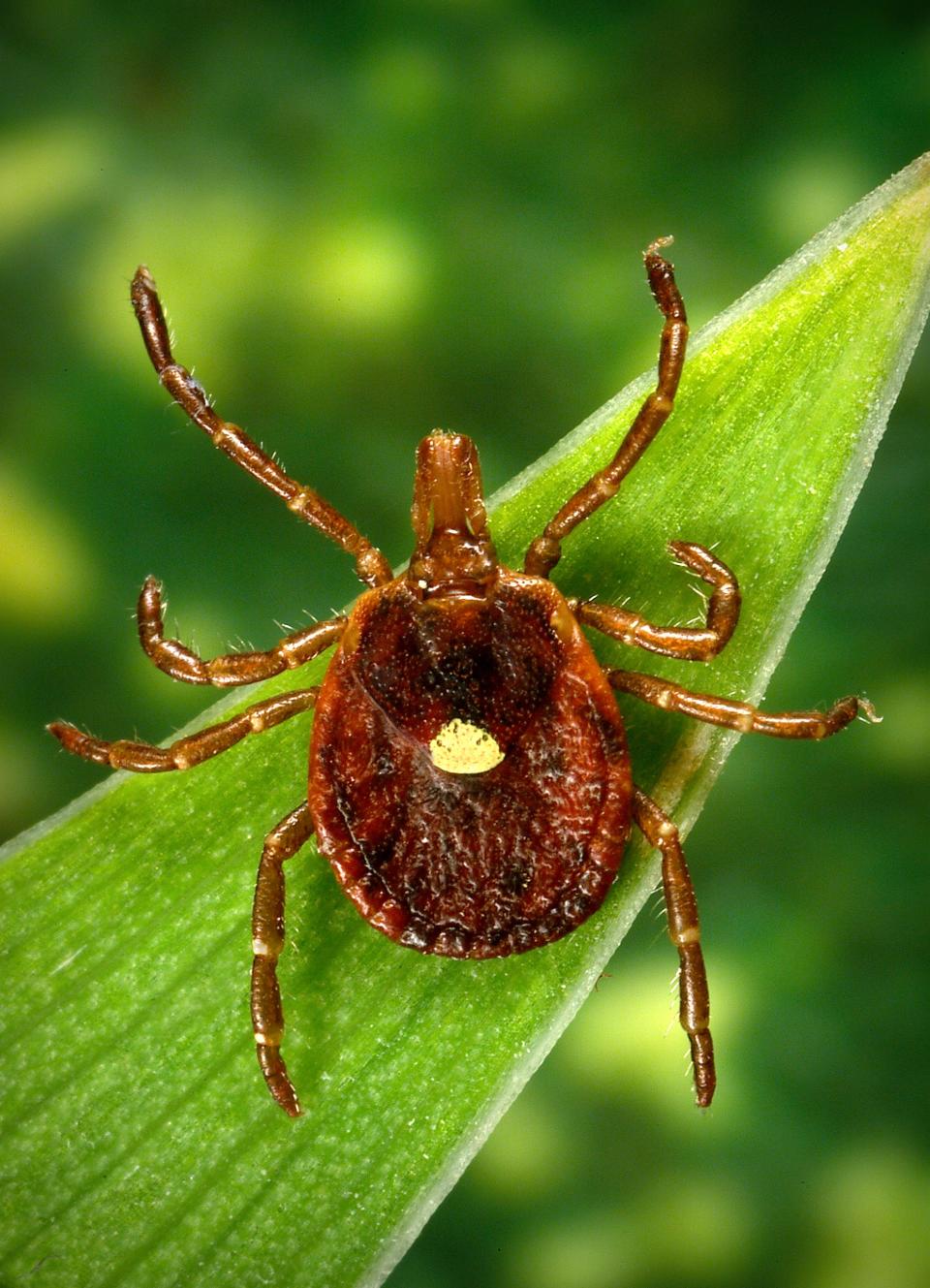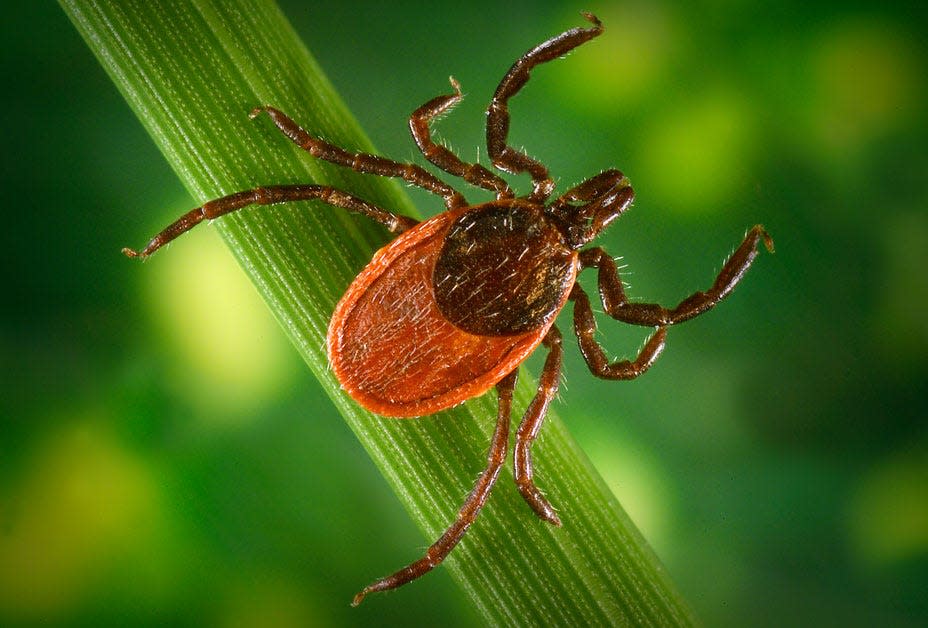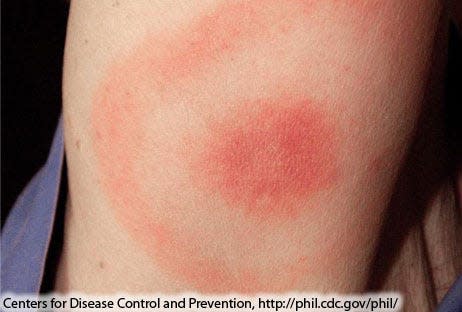Tick safety: A guide to avoiding ticks, treatments for bites and info about Lyme disease
We’ve waited months for warm weather to grace us so we can spend more time outdoors, but with warm weather comes pesky ticks.
As more people hike through summer grasses, play in backyards and camp in forests, ticks are taking the opportunity to shimmy up pantlegs, crawl through sleeves or land in your hair to do what they do best: feed on your blood.
Reports show some states are seeing an increased presence of ticks this spring and summer, and with them, a surge in Lyme disease cases.
Here’s the rundown of everything we know about tick presence, Lyme disease cases and tick bites in Delaware, including prevention, symptoms and treatment.
Where are ticks found?

Ticks dwell in a variety of habitats and can be found in forest, meadows and wetlands throughout Delaware. They live in yards and residential areas, too, according to the Delaware Department of Natural Resources and Environmental Control.
Wooded areas, tall grass or brush — the edges where woods and lawn meet — are desirable spots for ticks, along with leaf litter, beneath ground-cover plants and around woodpiles or stone walls where small mammals live.
From there, ticks can latch onto the birds, mammals or reptiles they prey on and spread to other organisms.
Ticks are active year-round if temperatures are above freezing.
What types of ticks are in Delaware?
While there are hundreds of species of ticks found worldwide and dozens in the United States, only a handful are commonly spotted in the First State.
Lone Star tick

The most common tick species in the area is the Lone Star tick, identifiable by a white dot on its back. Found all over the state, it is more common in Kent and Sussex counties.
And while it may be tiny, it sure is mighty.
Look out for these pests this summer: Invasive pest known as the citrus root weevil found at Port of Wilmington for first time
“It's described as being an aggressive biter,” said Ashley Kennedy, tick biologist at the Delaware Department of Natural Resources and Environmental Control. “The bite itself can be very painful, very itchy.”
A bite from a Lone Star tick could trigger flu-like illness or, in rare cases, alpha-gal syndrome, in which a person develops an allergy to red meat and other products made from mammals such as dairy.
Black-legged/deer tick

The black-legged/deer tick is not as common as other species but is more likely to infect you if it bites you.
One of the illnesses it can cause is Lyme disease, a bacterial infection that can spread to your joints, heart and nervous system if not treated early.
American dog tick

The American dog tick is the least likely to make you sick, but a small percentage of them carry Rocky Mountain spotted fever, Kennedy said.
Rocky Mountain spotted fever is a bacterial disease that begins with symptoms such as fever, headache and rash. It can be deadly if it is not treated early on with the correct antibiotics.
Asian longhorned tick

The newest Delaware tick species, first spotted in 2019, is the Asian longhorned tick.
This invasive species has a female-only population that can lay eggs without needing a male and occasionally bites.
What is Lyme disease?

A major concern when it comes to ticks is Lyme disease, the most common vector-borne disease in the U.S. but just one of 16 tickborne illnesses that can be passed to humans.
Summer brings hazards for dogs: Avoid these risks to dogs this summer as warm weather, pet dangers, amp up
It is transmitted to humans through the bite of an infected blacklegged tick and can lead to an infection of the joints, hearts and nervous system if left untreated. There is no evidence that the disease can be passed from person to person, according to the CDC.
Lyme disease accounts for approximately 30,000 of the reported tick-borne illnesses each year. The CDC suggests this number is actually closer to 476,000 due to underreporting when it comes to the disease.
Lyme disease in Delaware

In accordance with the Delaware Division of Public Health’s section of Epidemiology, Health Data and Informatics, the entity cannot disclose the current number of Lyme disease cases in Delaware, said Laura Matusheski, media relations coordinator for DPH.
“Delaware sees cases of Lyme disease in all three counties year-round and continues to monitor disease trends. People who spend time outdoors in grassy or wooded environments are at risk for increased exposure,” the Division of Public Health stated.
The CDC defines Delaware as a high-incidence state for Lyme disease, ranking it among the top 10 states for cases in the United States.
DPH tracks yearly totals for the number of Lyme disease cases reported in Delaware, and the number of cases per 100,000 people per year over the last five years are as follows:
In 2018, there were 540 cases of Lyme disease statewide per 100,000 people. New Castle County contributed 302 cases, followed by Kent County at 87 and Sussex County at 131.
In 2019, there were 659 cases statewide. New Castle County contributed 437, followed by 86 in Kent County and 136 in Sussex County.
In 2020, 353 cases were reported statewide. New Castle County contributed 249, Kent County contributed 43 and Sussex County contributed 161.
In 2021, 354 cases were reported statewide. New Castle County reported 250, Kent County reported 40 and Sussex County reported 64.
In 2022, the most recent year with data, 385 statewide cases were reported. New Castle County documented 253, Kent County documented 64 and Sussex County documented 68.
As the data shows, New Castle County has reported the highest incidence rates of Lyme disease compared with Kent and Sussex counties, at time documenting cases that are four times greater than throughout the rest of the state.
What are the symptoms of Lyme disease?
Lyme disease bacterium can infect several parts of the body and cause different symptoms at different times. Some of these symptoms may be nonspecific and resemble other diseases, according to the Division of Public Health.
Early symptoms of Lyme disease include:
Headache.
Fatigue.
An expanding red rash, commonly referred to as a bulls-eye rash. It can appear anywhere on the body and be warm to the touch but is usually not itchy or painful. Not all affected individuals will develop a rash.
Fever and/or chills.
Muscle and joint aches.
If left untreated, the following symptoms can occur:
Heart palpitations and dizziness.
Severe joint pain and swelling, usually in large joints like the knees.
Severe headaches and neck stiffness due to meningitis.
Loss of muscle tone on one or both sides of the face, called “Bell’s palsy.”
Neurological problems like numbness or tingling in extremities and problems with concentration and short-term memory.
If you think you have Lyme disease, contact your health care provider. Most cases of Lyme disease can be cured with antibiotics taken over the course of a few weeks, but the severity of symptoms and subsequent treatment may vary this timeline.
Some patients experience chronic symptoms months and years after the infection has cleared.
How to keep ticks away from your home

When it comes to keeping ticks away from you and your home, there are several ways you can decrease the presence of ticks on your property.
Keeping your grass mowed and removing leaf litter, brush and tall weeds from the edges of your lawn are routine ways to keep ticks out.
Other tactics from the CDC include:
Moving firewood, birdhouses and feeders away from your home. Wood should be stacked in a dry area.
Using plants that do not attract deer or exclude deer by using various types of fencing. Deer are the main food source for adult ticks.
Creating a 3-foot or wider wood chip, gravel or mulch barrier between your property and the woods.
Removing old furniture or trash, which ticks love to hide in, from your yard.
Keeping playground equipment, patios and decks away from yard edges and trees, instead placing them in sunny locations, if possible.
Tick bite prevention

Knowing where ticks usually dwell is the first step in preventing an encounter with them.
If you find yourself in a moist and humid environment that is near wooded or grassy areas, there are extra steps you can take to stay safe while in these places.
For those of you tasked with wading through fall leaves or tidying up the shrubs, wear light-colored clothing to allow you to see ticks crawling on you.
Protecting Piper: A rare bird has nested at a Delaware park, prompting a portion of beach to close
If you find yourself in an area ripe for ticks, be sure to wear long sleeves and pants. Tuck your pant legs into your socks and consider wearing a hair tie on your sleeves to prevent ticks from crawling into the openings of your clothes.
Other ways to prevent tick bites, according to DPH, include:
Applying tick repellent that contains DEET. This lasts only a few hours and needs to be reapplied as necessary. Adults should use a repellent containing less than 50% DEET. Children’s repellents should contain less than 30% DEET. Do not use repellents with DEET on infants under 2 months old.
Searching your body for ticks during and after an outing. Be thorough when checking under your arms, inside your belly button, in and around your ear, behind the knees, between the legs, around the waist and in and around all head and body hair.
Checking children and pets for ticks. Your beloved pet probably has no clue a tick just latched onto him for a free ride into the house after a round of fetch. Giving your kids another look after they check for ticks can’t hurt either.
Symptoms of a tick bite

If you suspect you have been bitten by a tick, many tickborne illnesses share similar signs and symptoms.
See your health care provider if you develop the following symptoms within a few weeks of a tick bite:
Fever or chills: All tickborne diseases can cause fever.
Rash: Lyme disease, Southern tick-associated rash illness, Rocky Mountain spotted fever, ehrlichiosis and tularemia can cause distinctive rashes.
Aches and pains: Tickborne diseases can cause headaches, fatigue and muscle aches.
Tick bite treatment
After spending the day outdoors, your tick check might alert you to some unwelcome hitchhikers on your body.
If you discover a tick on you or your pets, do not use home remedies like petroleum jelly or hot matches to remove the ticks. They do not work, the Division of Public Health said.
Instead, use these steps to help rid yourself of ticks:
Use fine-tipped tweezers or shield your fingers with a paper towel, rubber gloves or a tissue to remove ticks. Do not pick at them with bare hands.
Grasp the tick close to the skin surface and pull upward with steady, even pressure.
Do not squeeze, crush or puncture the body of the tick. Its fluids, such as saliva, body fluids and gut contents, may contain infectious germs.
After removing the tick, clean the removal spot with an antiseptic or soap water. Don’t forget to wash your hands afterward!
Got a tip or a story idea? Contact Krys'tal Griffin at kgriffin@delawareonline.com.
This article originally appeared on Delaware News Journal: Tick bite prevention, symptoms, treatments and Lyme disease data

